
DOMS- Post Exercise Muscle Soreness
What is DOMS?
Delayed Onset Muscle Soreness
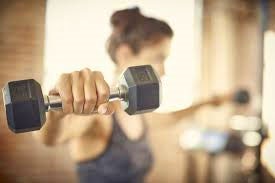 Delayed-Onset Muscle Soreness (DOMS), also known as muscle fever, it is an exercise-related muscle pain. It develops after excessive and unaccustomed exercise session. It is particularly prevalent if that exercise has an eccentric component. Eccentric exercise is an exercise where the muscles are contracting while lengthening – e.g. downhill running, long-distance running, plyometric exercises, and landing drills.
Delayed-Onset Muscle Soreness (DOMS), also known as muscle fever, it is an exercise-related muscle pain. It develops after excessive and unaccustomed exercise session. It is particularly prevalent if that exercise has an eccentric component. Eccentric exercise is an exercise where the muscles are contracting while lengthening – e.g. downhill running, long-distance running, plyometric exercises, and landing drills.
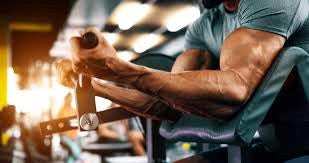 This is different from the immediate muscle soreness you feel during a workout, which is called an acute muscle soreness where you feel a burning sensation in the muscles that you are working on due to a rapid build-up of lactic acid and it usually disappear shortly after you’ve finished the exercise. DOMS is a delayed muscle soreness that usually peak within one or two days after the workout session and you will not feel DOMS during a workout.
This is different from the immediate muscle soreness you feel during a workout, which is called an acute muscle soreness where you feel a burning sensation in the muscles that you are working on due to a rapid build-up of lactic acid and it usually disappear shortly after you’ve finished the exercise. DOMS is a delayed muscle soreness that usually peak within one or two days after the workout session and you will not feel DOMS during a workout.
What Causes DOMS?
DOMS is myofibril tears (muscle strains). The body response to this by increasing inflammation, which causes the delayed onset of muscle soreness you feel. We do know that biochemical markers (such as creatine kinase and lactic dehydrogenase) are in the blood of DOMS sufferers, which is consistent with muscle fibre disruption. Any high-intensity exercise may lead to DOMS and as we mentioned above, eccentric exercise is most likely to trigger DOMS.
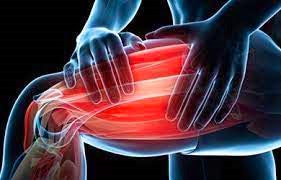 DOMS can affect anyone, ranging from professional athletes to beginners as long as there is a sudden increase in your workout intensity, performing eccentric exercises or even trying a new exercise that your body is not accustomed to.
DOMS can affect anyone, ranging from professional athletes to beginners as long as there is a sudden increase in your workout intensity, performing eccentric exercises or even trying a new exercise that your body is not accustomed to.
What are the Symptoms of DOMS?
Some common symptoms of DOMS might include:
- Dull muscle ache 24-48 hours after exercise
- Muscles are tender to touch
- Muscle fatigue
- Unable to achieve full range of motion due to pain and stiffness while moving
- Short-term reduction in muscle strength
- Muscle swelling
Do you need to have DOMS to achieve fitness gains?
Absolutely no. Majority of people thinks that “no pain no gain” is applicable to DOMS and you need to feel super sore after every workout to make any fitness gains. But that is not the case.
When you push yourself to your limit or just started a new exercise routine, you are more likely to experience DOMS. However, as you keep on with your exercise routine and after a period of time, your body will starts to adapt and you may feel less and less sore with each workout session. Eventually, you may reach a point where you do not get any DOMS at all, but that does not mean that you are not working out hard enough or not gaining any fitness progress.
How is DOMS Diagnosed?
DOMS is a clinical diagnosis. Your chiropractor is a specialist in determining if you have DOMS and ruling out other more serious injuries including muscle tears, strains, or ruptures. While an ultrasound scan is ineffective in diagnosing DOMS, it may help decide whether there is a more serious muscle tear.
How to treat DOMS?
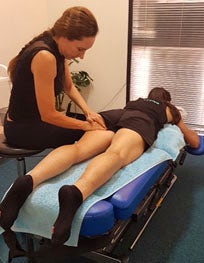 The initial treatment protocol for DOMS is active rest and ice to calm down the inflammation and ease the pain. You can also take a stroll around to help with the pain and stiffness.
The initial treatment protocol for DOMS is active rest and ice to calm down the inflammation and ease the pain. You can also take a stroll around to help with the pain and stiffness.
There are tons of research done to find out the best treatment option for DOMS, however, the results are mixed and more study is needed. Here are some treatments suggested by some studies that may help with DOMS:
Massage
People who got a massage 24 hours, 48 hours, or 72 hours after an intense workout showed substantially less soreness than people who didn't get a post-workout massage, according to a 2017 review of several studies. Getting a massage 48 hours after a workout seemed to be the most successful.
You may not be able to get a massage after each and every exercise, but you should try self-massage on your:
- calves
- thighs
- buttocks
- arms
- shoulders
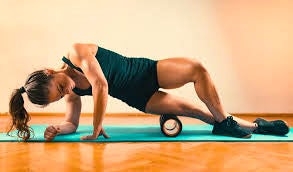 Apply some oil or lotion to the area and knead, pinch, and gently shake the muscles to massage them.
Using a foam roller immediately after a workout will also help prevent DOMS.
Apply some oil or lotion to the area and knead, pinch, and gently shake the muscles to massage them.
Using a foam roller immediately after a workout will also help prevent DOMS.
Topical analgesics
Topical analgesics are medications that are applied to the skin to assist with pain relief. Topical analgesics containing menthol, as well as those containing arnica, can help with DOMS pain. These products can be applied to the inflamed region topically. Always follow the guidelines on the packaging on how much to use and how frequently to apply it.
Cold bath
An analysis of studies published in 2016 found that a 10- to 15-minute full-body immersion in a cold water bath (50–59°F or 10–15°C) may help reduced DOMS severity.
Some competitive athletes are also using cold baths as a self-treatment.
Warm bath
If ice bath sounds a little too much for you, you can always try soaking in a warm tub instead. The pain and stiffness from DOMS may be eased with the help of moist heat wraps or a warm bath.
Anti-inflammatory foods
More research is required, but some studies suggest that certain foods or supplements can help alleviate DOMS.
to seek medical help
DOMS almost never necessitates a trip to the doctor. If the pain from DOMS prevents you from performing your usual everyday routines, it is advises that you see a practitioner.
If you have any of the following symptoms, you should seek medical help right away:
- Your DOMS lasts more than 7 days
- Your urine is an abnormal brown colour
- You have extreme swelling in your arms and legs
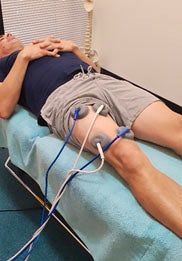 Sharp pain, muscle spasms, numbness, and tingling are not the same as muscle soreness, which is a dull ache. If you have some of these signs after working out, contact your chiropractor right away.
Sharp pain, muscle spasms, numbness, and tingling are not the same as muscle soreness, which is a dull ache. If you have some of these signs after working out, contact your chiropractor right away.
Is it possible to avoid DOMS?
You will not be able to completely stop DOMS, but you may take precautions to reduce the severity. Consider the following suggestions:
- Keep yourself hydrated. According to one study, Men who exercised in hot, humid weather had a significant reduction in muscle soreness when they drank water before, during, and after exercise
- Warm up your body. Spend 5 to 10 minutes stretching dynamically before each exercise. Wait right after the exercise to do static stretching.
- Allow yourself to relax. According to a 2012 study, after a lower-body strength training session, a 20-minute cool down of low-intensity cycling can reduce the quadriceps muscle soreness two days later. Finish the cool down with some static stretching. It won't help with DOMS, but it can help with joint and muscle endurance.
- Take it easy. Step up the intensity of the exercises one little step at a time. This will allow you to comfortably increase your strength and stamina while reducing the effects of DOMS.
How we at Lakeside Chiropractic may help with your DOMS!
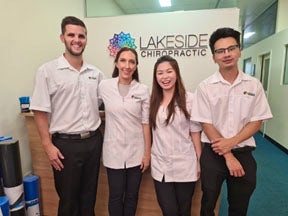 At Lakeside Chiropractic, we provide soft tissue therapy, massage, and cold laser therapy that may help to relief some of the deeper muscles and get you back to your exercise routine as soon as possible. Lakeside chiropractic is located in Joondalup in Perth’s north and has visitors from many different suburbs including, Padbury, Kinross, Mindarie, Sorrento, Iluka, Carramar, Currambine, Tapping, Pearsall, Hocking and Woodvale. HICAPS Facilities available on site for major private health insurers (NIB, HCF, HBF, AHM, HCI and HIF) and also a part of the Medibank preferred practitioner and BUPA Members first network. If you would like to discuss any concerns, have any enquires or wish to book an appointment; feel free to contact one of our friendly staff on 9300 0095 or visit our website at www.lakesidechiro.com.au.
At Lakeside Chiropractic, we provide soft tissue therapy, massage, and cold laser therapy that may help to relief some of the deeper muscles and get you back to your exercise routine as soon as possible. Lakeside chiropractic is located in Joondalup in Perth’s north and has visitors from many different suburbs including, Padbury, Kinross, Mindarie, Sorrento, Iluka, Carramar, Currambine, Tapping, Pearsall, Hocking and Woodvale. HICAPS Facilities available on site for major private health insurers (NIB, HCF, HBF, AHM, HCI and HIF) and also a part of the Medibank preferred practitioner and BUPA Members first network. If you would like to discuss any concerns, have any enquires or wish to book an appointment; feel free to contact one of our friendly staff on 9300 0095 or visit our website at www.lakesidechiro.com.au.



